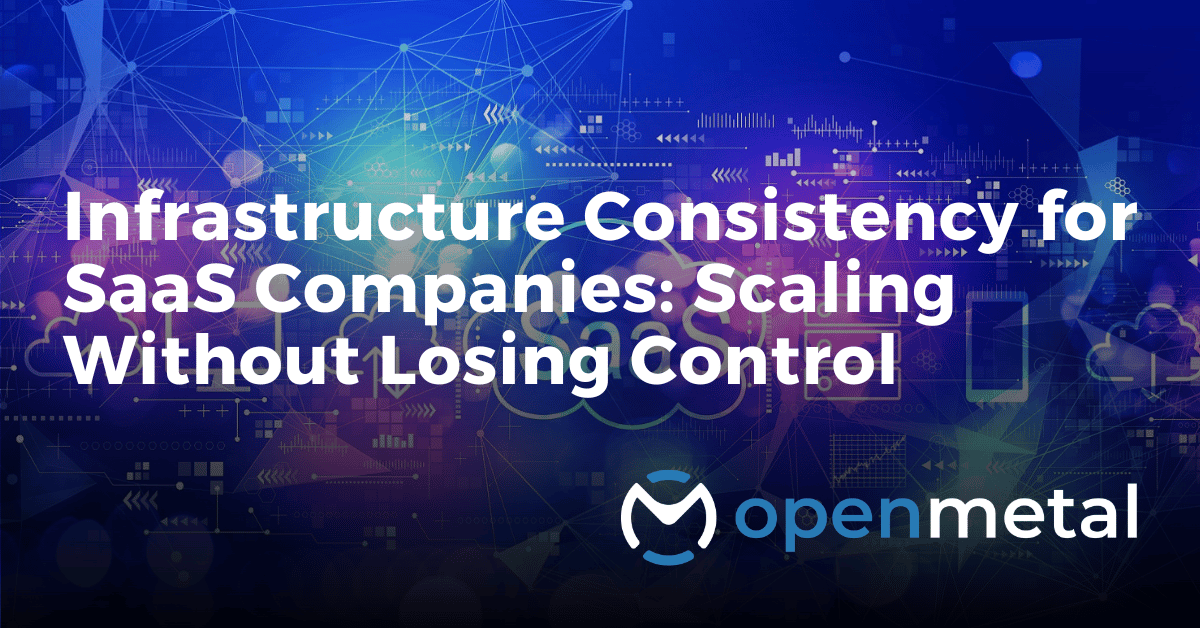
Infrastructure inconsistency is the silent killer of SaaS scalability. If you’re a technical leader at a fast-growing SaaS company, you’ve likely witnessed this evolution: what started as a clean, well-architected platform gradually becomes a patchwork of different deployment patterns, varying configuration standards, and inconsistent performance profiles across environments. The result isn’t just technical debt—it’s operational risk that can derail growth when you can least afford disruption.
The challenge isn’t simply about maintaining clean code or following best practices. Infrastructure inconsistency creates cascading problems that impact every aspect of your platform: unpredictable performance during traffic spikes, security gaps that emerge from configuration drift, and troubleshooting complexity that slows your team’s ability to respond when issues arise.
For SaaS companies experiencing rapid growth, achieving infrastructure consistency without sacrificing the agility that got you this far requires a different approach than traditional enterprise solutions. You need dedicated infrastructure that provides control and predictability while maintaining the deployment speed and operational flexibility that fast-growing companies require.
What Drives Infrastructure Inconsistency in Growing SaaS Companies?
The path to infrastructure inconsistency rarely starts with poor planning. Most SaaS companies begin with thoughtful architecture decisions and clear deployment standards. However, several factors compound as companies scale, gradually eroding the consistency that teams initially established.
Rapid Feature Development Pressure
Growth-stage SaaS companies face constant pressure to ship features quickly to meet customer demands and competitive threats. Under these conditions, teams often make expedient infrastructure decisions that deviate from established patterns. A database might get deployed with different configuration parameters to meet a deadline, or a new microservice might launch with different monitoring setups because the standard approach would delay release.
These individual deviations seem minor when viewed in isolation, but they accumulate over time to create an infrastructure landscape where no two components behave identically. What started as temporary workarounds become permanent architectural decisions simply because teams lack time to revisit and standardize them.
Multi-Environment Complexity
SaaS companies typically manage multiple environments—development, staging, production, and often additional environments for feature branches or customer-specific deployments. Maintaining configuration consistency across these environments becomes increasingly difficult as the number of services and deployment variables grows.
The challenge intensifies when different team members deploy to different environments using slightly different processes or tools. Development environments might use one container orchestration approach while production uses another, creating situations where applications behave differently across environments despite running identical code.
Public Cloud Resource Constraints
In typical public cloud deployments, workloads use roughly 30% of allocated resources on average and burst to use no more than 30% more over time, leaving approximately 40% of VM resources wasted. This inefficiency forces teams to make compromises between cost optimization and performance consistency.
When you’re constrained by predetermined instance types, achieving consistent resource allocation across different application components becomes difficult. Some services might run on instances with excess CPU but insufficient memory, while others have the opposite problem. These mismatches create performance variations that compound as applications scale.
Tool and Platform Proliferation
Growing engineering teams often adopt new tools and platforms to solve specific problems without considering the impact on overall infrastructure consistency. One team might implement a new monitoring solution for their service, another might adopt a different deployment pipeline, and a third might choose an alternative database technology for specific requirements.
While each decision might be technically sound in isolation, the cumulative effect creates an infrastructure environment where troubleshooting requires knowledge of multiple tools, security policies must account for various platforms, and operational procedures become service-specific rather than standardized.
The Operational Risks of Infrastructure Drift
Infrastructure inconsistency creates several categories of operational risk that become more severe as SaaS companies scale and serve more demanding customers.
Performance Unpredictability During Traffic Spikes
When infrastructure configurations vary across services, predicting how your platform will behave under load becomes nearly impossible. Services might handle normal traffic loads similarly but respond very differently when traffic increases during marketing campaigns, product launches, or seasonal usage patterns.
This unpredictability becomes particularly problematic for SaaS companies serving enterprise customers with strict service level agreements. A customer onboarding surge that should be manageable suddenly overwhelms services that were configured differently from the rest of your platform, creating performance issues that impact customer experience and damage your reputation.
Security Gaps from Configuration Drift
Security vulnerabilities often emerge not from intentional weaknesses but from configuration inconsistencies that create gaps in your security posture. When different services use different security policies, networking configurations, or access controls, maintaining comprehensive security becomes significantly more complex.
For example, one service might implement proper database encryption while another uses an older configuration that doesn’t include the same protections. These inconsistencies create attack vectors that security audits might miss because they focus on individual components rather than the interactions between differently configured services.
Troubleshooting Complexity
Infrastructure inconsistency makes incident response significantly more difficult and time-consuming. When each service has unique configuration parameters, deployment processes, and monitoring setups, engineers must understand multiple approaches to effectively diagnose and resolve issues.
During critical incidents, this complexity translates directly to longer resolution times. Engineers waste valuable time determining which troubleshooting procedures apply to the affected service before they can begin actual problem diagnosis. For SaaS companies where downtime directly impacts customer experience and revenue, these delays can be costly.
Compliance and Audit Challenges
SaaS companies serving enterprise customers increasingly face compliance requirements that demand consistent security and operational practices across their entire platform. Infrastructure inconsistency makes demonstrating compliance much more difficult because auditors must evaluate multiple different configurations and processes rather than a single standardized approach.
This complexity increases both the time and cost associated with compliance efforts while creating additional risk that inconsistencies might be overlooked during audit processes.
Private Cloud Solutions for SaaS Infrastructure Consistency
Traditional approaches to infrastructure consistency—configuration management tools, infrastructure as code, and deployment automation—provide important capabilities but often fall short of addressing the fundamental challenges facing growing SaaS companies. These tools can standardize configurations, but they don’t address the underlying resource allocation and performance variability issues created by shared cloud environments.
Private cloud infrastructure addresses infrastructure consistency challenges at a more fundamental level by providing dedicated resources that eliminate the performance variability and resource allocation constraints inherent in public cloud environments.
Dedicated Resource Allocation
Private equity-backed SaaS companies often face a tough challenge: reduce infrastructure costs without disrupting performance or slowing growth. That’s easier said done when teams are spread across different platforms or relying on public cloud providers where usage-based pricing and multi-tenant environments make it difficult to predict spend or optimize configurations.
OpenMetal gives portfolio companies the ability to launch dedicated private cloud environments that behave like public cloud — but with fully isolated infrastructure, clear costs, and no long-term commitments. These environments run on dedicated hardware and can be live in less than 45 minutes. Because you’re not sharing resources with other tenants, you’re not affected by noisy neighbors or the limitations of someone else’s architecture.
When your infrastructure runs on dedicated hardware, you control resource allocation decisions based on your actual application requirements rather than working within the constraints of predetermined instance types. This control enables consistent resource allocation across all your services, eliminating the performance variations that emerge from mismatched instance configurations.
Consistent Performance Characteristics
Everything is yours so your team has complete control over how they deploy, scale, and budget. This control extends to performance characteristics, allowing you to establish consistent response times, throughput levels, and resource utilization patterns across your entire platform.
Unlike shared cloud environments where performance can vary based on the activity of neighboring tenants, dedicated private cloud infrastructure provides predictable performance that your teams can plan around. This predictability becomes particularly valuable for SaaS companies with performance-sensitive applications or customers with strict SLA requirements.
Standardized Deployment Environments
OpenMetal pricing is flat-rate and easy to understand. There are no surprise egress fees or vague licensing costs, and teams aren’t locked into instance types that don’t match their workloads. If one SaaS company is in growth mode and another is stabilizing, you can provision environments that match their stage — from a Medium V4 with Ceph for smaller, more agile teams to Large or XL configurations for companies running heavier workloads.
This flexibility enables teams to create consistent deployment environments that match their actual requirements rather than adapting their applications to fit available instance types. When all your environments use the same underlying resource allocation approach, maintaining consistency across development, staging, and production becomes significantly easier.
Implementing Infrastructure Consistency Without Sacrificing Agility
The key to achieving infrastructure consistency while maintaining development velocity lies in establishing standards that support rather than constrain rapid development and deployment cycles.
Standardized Resource Templates
Rather than prescriptive configurations that limit flexibility, effective infrastructure consistency uses standardized resource templates that provide consistent foundations while allowing customization for specific application requirements. These templates establish baseline security, monitoring, and performance configurations while permitting teams to adjust resources based on their specific needs.
For SaaS companies, this approach means creating templates for common application patterns—web services, background processors, databases—that teams can deploy consistently while retaining the ability to customize resources for specific performance or feature requirements.
Environment Parity Through Dedicated Infrastructure
Achieving true environment parity requires infrastructure that can provide consistent resources across development, staging, and production environments. Public cloud environments often force compromises where development environments use different instance types or configurations than production due to cost constraints.
Dedicated private cloud infrastructure eliminates these compromises by providing consistent resources that teams can allocate appropriately across all environments. SaaS companies benefit from this consistency because it reduces the likelihood of environment-specific issues that only emerge during production deployment.
Automated Compliance and Security
Infrastructure consistency becomes much easier to maintain when security and compliance requirements are built into deployment templates rather than applied afterward. This approach ensures that all new services automatically inherit appropriate security configurations, networking policies, and monitoring setups.
For SaaS companies facing increasing compliance requirements, this automation reduces the operational overhead associated with maintaining security standards while ensuring that rapid development cycles don’t compromise security posture.
Use Cases: Consistency Preventing Critical Issues
Understanding how infrastructure consistency prevents operational problems requires examining specific scenarios where inconsistency creates significant business risk.
Scenario 1: Traffic Surge During Product Launch
A growing SaaS company launches a major new feature that drives a 300% increase in user activity over a weekend. Services that were deployed using standardized resource allocation and configuration templates handle the load increase smoothly, scaling predictably based on established performance characteristics.
However, one critical service was deployed using a different configuration approach to meet a previous deadline. This service uses an instance type with insufficient memory allocation for high-traffic scenarios, creating a bottleneck that affects the entire platform’s performance during the launch period.
With consistent infrastructure allocation, all services would have been configured with appropriate resource ratios for their workload patterns, preventing the bottleneck that damaged the launch’s success.
Scenario 2: Security Audit Reveals Configuration Gaps
An enterprise customer requires a comprehensive security audit before signing a significant contract. The audit reveals that while most services implement proper encryption and access controls, several services deployed during rapid development periods use different security configurations that don’t meet the customer’s requirements.
Addressing these inconsistencies requires significant engineering effort to update configurations, validate changes, and re-implement security measures that should have been standardized from the beginning. The contract gets delayed while teams address the security gaps, impacting revenue projections for the quarter.
Scenario 3: Debugging Performance Issues Across Services
A SaaS platform experiences intermittent performance issues that affect customer experience but are difficult to reproduce consistently. Investigation reveals that different services use different monitoring configurations, making it difficult to correlate performance metrics across the platform.
Some services log detailed performance data while others use minimal monitoring. Network configurations vary between services, creating different latency characteristics. Database connection pooling implementations differ across services, leading to resource contention patterns that are difficult to identify.
Engineers spend weeks developing service-specific debugging approaches rather than using standardized procedures, significantly increasing the time required to identify and resolve the performance issues.
Best Practices for SaaS Infrastructure Standardization
Implementing infrastructure consistency requires systematic approaches that balance standardization with the flexibility that growing SaaS companies need.
Infrastructure as Code with Consistent Patterns
Effective infrastructure consistency starts with infrastructure as code implementations that establish consistent patterns while allowing customization for specific requirements. Rather than rigid templates, successful approaches use parameterized configurations that teams can adapt while maintaining core consistency.
This approach works particularly well with private cloud hosting because teams aren’t constrained by predetermined instance types or configuration limitations. You can establish resource allocation patterns based on your actual application behavior rather than working within public cloud constraints.
Monitoring and Alerting Standardization
Consistent monitoring implementations enable teams to understand performance patterns across their entire platform rather than managing service-specific monitoring approaches. This consistency becomes particularly valuable during incident response when engineers need to quickly understand how issues impact different parts of the platform.
Standardized alerting ensures that performance thresholds, error rates, and resource utilization metrics are evaluated consistently across all services. This consistency helps teams identify systemic issues rather than treating symptoms in individual services.
Automated Testing for Infrastructure Changes
Infrastructure changes should be tested as rigorously as application code changes. Automated testing for infrastructure modifications helps prevent configuration drift by validating that changes maintain consistency with established standards.
For SaaS companies, this testing becomes particularly important when deploying to multiple environments or when multiple teams make infrastructure changes simultaneously. Automated validation ensures that expedient changes don’t introduce inconsistencies that create operational problems later.
Sizing Infrastructure for Different SaaS Growth Stages
Infrastructure requirements vary significantly as SaaS companies progress through different growth stages, but the need for consistency remains constant throughout this evolution.
Early-Stage Consistency
Companies in early growth phases benefit from establishing consistency patterns even when resource requirements are relatively modest. OpenMetal’s Medium V4 configurations provide sufficient resources for most early-stage SaaS applications while establishing the infrastructure patterns that will scale as the company grows.
The key advantage of starting with consistent infrastructure patterns early is that teams develop operational practices around standardized approaches. This foundation prevents the configuration drift that often occurs when companies try to implement consistency after they’ve already scaled to complex infrastructure environments.
Growth-Stage Infrastructure Scaling
As SaaS companies experience rapid customer growth, their infrastructure needs evolve from simple web applications to complex platforms with multiple services, background processing, and data analytics requirements. Private cloud configurations can scale to meet these requirements while maintaining the consistency patterns established during earlier growth phases.
You’re not paying for more than you need, and you’re not boxed into less than you can use. For PE firms looking to reduce cloud spend across a portfolio and increase EBITDA, this flexibility makes infrastructure consistency a strategic advantage rather than an operational constraint.
Enterprise-Scale Infrastructure Requirements
SaaS companies serving enterprise customers often require infrastructure that can handle complex deployment scenarios, strict performance requirements, and comprehensive compliance controls. Infrastructure considerations for enterprise SaaS include data isolation, performance predictability, and security controls that become much easier to implement consistently when using dedicated infrastructure.
High-growth software companies often trade at 24-25x gross profit multiples, meaning every dollar of gross profit saved through infrastructure optimization translates to $24-25 in market capitalization gains. For growing SaaS companies, infrastructure efficiency directly impacts both operational performance and business valuations.
The Cost Impact of Infrastructure Inconsistency
Infrastructure inconsistency creates several categories of hidden costs that compound as SaaS companies scale.
Engineering Productivity Overhead
When infrastructure configurations vary across services, engineering teams spend significantly more time on operational tasks rather than feature development. Debugging issues requires service-specific knowledge, deployment procedures vary between components, and performance optimization becomes a custom project for each service rather than a systematic improvement.
This productivity overhead becomes particularly expensive for SaaS companies where engineering talent represents a significant portion of operational costs. When senior engineers spend time troubleshooting infrastructure inconsistencies rather than building customer-facing features, the opportunity cost impacts both current productivity and future growth potential.
Incident Response Complexity
Public cloud costs can reach 50% of total cost of revenue for software companies, and the unpredictability makes budgeting nearly impossible. Beyond direct cost implications, infrastructure inconsistency significantly increases incident response times, which translates directly to customer impact and revenue loss for SaaS companies.
Complex troubleshooting procedures, inconsistent monitoring data, and service-specific operational knowledge requirements all contribute to longer resolution times during critical incidents. For SaaS companies with enterprise customers or strict SLA commitments, these delays create both immediate revenue impact and longer-term customer satisfaction issues.
Operational Scaling Challenges
As SaaS companies grow their engineering teams, infrastructure inconsistency creates training overhead and knowledge transfer challenges that limit operational scaling effectiveness. New team members must learn multiple deployment approaches, troubleshooting procedures, and operational practices rather than mastering a single consistent approach.
This complexity slows onboarding processes and requires more senior engineering time for training and knowledge transfer. For rapidly growing companies, these scaling inefficiencies can become significant constraints on growth velocity.
Building Your Infrastructure Consistency Strategy
Implementing infrastructure consistency requires systematic planning that accounts for both current requirements and future growth scenarios.
Assessment and Planning
Begin by auditing current infrastructure configurations to identify inconsistencies and their impact on operational efficiency. This assessment should examine resource allocation patterns, deployment procedures, monitoring implementations, and security configurations across all services.
Understanding your current infrastructure challenges helps prioritize which inconsistencies create the most significant operational risk and should be addressed first. Focus on changes that deliver immediate improvements in incident response capabilities and performance predictability.
Phased Implementation Approach
Rather than attempting to standardize all infrastructure simultaneously, successful consistency implementations use phased approaches that address the most critical inconsistencies first while building toward comprehensive standardization.
Start with infrastructure components that impact multiple services—networking configurations, monitoring setups, security policies—before addressing service-specific configurations. This approach delivers immediate operational improvements while building the foundation for comprehensive consistency.
Team Training and Process Development
Infrastructure consistency requires both technical implementations and operational process changes. Teams need training on standardized approaches, and deployment procedures must be updated to maintain consistency as new services are deployed.
Develop documentation and training materials that focus on the operational benefits of consistency rather than just the technical requirements. When teams understand how standardization improves their daily work experience, adoption becomes much more effective.
Measuring Success: KPIs for Infrastructure Consistency
Tracking the right metrics helps teams understand the impact of infrastructure consistency initiatives and identify areas that need additional attention.
Incident Response Metrics
Mean time to resolution (MTTR) for infrastructure-related incidents provides a clear indicator of how consistency impacts operational efficiency. As infrastructure becomes more standardized, incident response times should decrease because troubleshooting procedures become more predictable.
Track the percentage of incidents that require service-specific knowledge or procedures versus those that can be resolved using standardized approaches. Increasing standardization should correlate with a higher percentage of incidents that can be resolved using standard procedures.
Deployment Velocity and Reliability
Deployment frequency and deployment success rates indicate how consistency impacts development productivity. Standardized infrastructure should enable more frequent deployments with higher success rates because teams can rely on established patterns rather than developing custom approaches for each service.
Monitor the time required to deploy new services or major updates. Consistent infrastructure patterns should reduce deployment preparation time and improve deployment predictability.
Performance Predictability
Track performance variance across similar services to measure infrastructure consistency effectiveness. Services with consistent resource allocation and configuration should demonstrate similar performance characteristics under equivalent load conditions.
Monitor the frequency of performance-related issues that result from infrastructure inconsistencies rather than application-level problems. Effective consistency initiatives should reduce the number of performance issues that stem from configuration differences between services.
Getting Started: Your Infrastructure Consistency Implementation Plan
For technical leaders ready to address infrastructure consistency challenges, implementation success depends on systematic planning and execution that accounts for both technical requirements and organizational change management.
Initial Assessment and Prioritization
Conduct a comprehensive audit of current infrastructure configurations, focusing on identifying inconsistencies that create the most significant operational risk. Map out dependencies between services to understand how inconsistencies in one area impact other parts of your platform.
Prioritize changes based on their impact on incident response capabilities, performance predictability, and development productivity. Focus initial efforts on infrastructure components that affect multiple services rather than service-specific configurations.
Technical Architecture Planning
Design infrastructure templates and patterns that provide consistency while maintaining the flexibility your teams need for specific requirements. Consider how these patterns will evolve as your platform scales and you deploy new services.
Evaluate infrastructure platforms that support your consistency goals without constraining development velocity. Private cloud infrastructure often provides the control and predictability that growing SaaS companies need while maintaining the deployment flexibility that supports rapid development cycles.
Implementation and Change Management
Develop implementation timelines that account for both technical changes and team training requirements. Plan for gradual transitions that don’t disrupt current operations while building toward comprehensive consistency.
Create documentation and training materials that help teams understand both the technical implementation details and the operational benefits of infrastructure consistency. When teams understand how standardization improves their daily work experience, adoption becomes much more effective.
Ready to achieve infrastructure consistency without sacrificing agility? For SaaS leaders scaling infrastructure, dedicated private clouds offer control and flexibility as companies grow. OpenMetal’s hosted private cloud ensures consistency, predictable costs, and flexibility for SaaS companies scaling quickly.
Explore how private cloud can provide infrastructure consistency for your SaaS platform →
Read More on the OpenMetal Blog


































